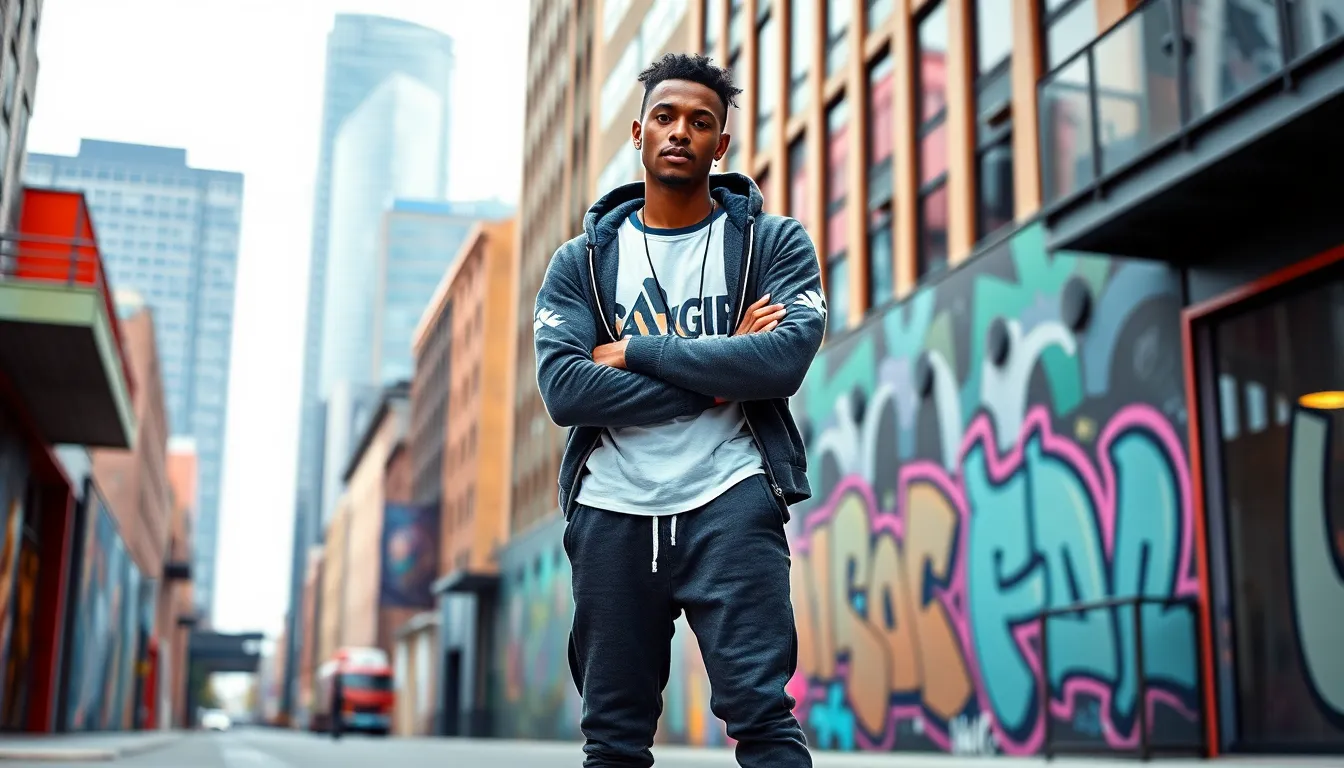Table of Contents
ToggleWhen I think back to 2000s streetwear, I’m instantly transported to an era that revolutionized fashion through bold graphics, oversized silhouettes and unapologetic self-expression. Those years marked a pivotal shift in how we approached casual fashion blending hip-hop culture with skate aesthetics and luxury influences.
I’ve watched the evolution of iconic brands like BAPE, Supreme and Stussy as they transformed from underground labels into global powerhouses during this defining decade. The 2000s weren’t just about clothes – they represented a cultural movement where streetwear became the voice of youth culture bridging the gap between high fashion and street style. From baggy jeans to fitted caps the influence of this era continues to shape today’s fashion landscape.
Key Takeaways
- The 2000s marked a transformative period for streetwear, evolving from underground culture to mainstream fashion through digital connectivity, music industry influence, and increased retail accessibility.
- Key brands like Supreme, BAPE, and BBC/Ice Cream defined the era through limited-edition drops, exclusive collaborations, and innovative retail strategies that continue to influence modern fashion.
- Hip-hop artists and celebrities played a crucial role in popularizing streetwear, with figures like Pharrell Williams, Kanye West, and Jay-Z elevating brands through collaborations and personal style.
- Signature pieces included oversized graphic tees, baggy denim, cargo pants, and limited-edition sneakers, characterized by bold logos, utility features, and maximalist designs.
- The sneaker culture revolution of the 2000s established new paradigms in footwear through exclusive collaborations and iconic silhouettes that remain influential today.
- Modern streetwear continues to reflect 2000s influences through drop culture, brand collaborations, design elements, and a thriving resale market for vintage pieces.
The Rise of Streetwear Culture in the 2000s
Streetwear culture experienced unprecedented growth during the 2000s, transforming from niche underground movements into mainstream fashion phenomena. Three key factors drove this expansion: digital connectivity, music industry influence, and retail accessibility.
The emergence of online forums and early social media platforms created dedicated spaces for streetwear enthusiasts. Communities like NikeTalk and Hypebeast forums connected collectors, resellers, and fashion enthusiasts across geographical boundaries, establishing a global network of streetwear culture.
Hip-hop’s dominance in mainstream music amplified streetwear’s visibility. Artists like Pharrell Williams, Kanye West, and Nelly popularized brands through their music videos, lyrics, and personal style choices:
- Pharrell showcased BAPE’s colorful camo prints
- Kanye West elevated luxury streetwear collaborations
- Nelly promoted Air Force 1s through his hit song
The retail landscape evolved to accommodate growing demand:
- Specialty boutiques opened in major cities (Union LA, Reed Space)
- Department stores added streetwear sections
- Online retailers launched exclusive drops
- Pop-up shops created limited-time experiences
Here’s a snapshot of streetwear’s market growth during the 2000s:
| Year | Market Value (USD) | Notable Developments |
|---|---|---|
| 2000 | $100M | Online forums emerge |
| 2005 | $500M | Celebrity collaborations begin |
| 2009 | $2B | Global retail expansion |
The DIY ethos of streetwear culture encouraged independent designers to launch their own brands. This democratization of fashion created opportunities for emerging creators while establishing new distribution channels through:
- Limited edition releases
- Exclusive collaborations
- Direct-to-consumer sales
- Underground markets
The intersection of music, art, and fashion in the 2000s streetwear scene created a self-sustaining ecosystem that continues to influence contemporary fashion trends.
Key Brands That Defined the Era

The 2000s streetwear landscape was dominated by influential brands that revolutionized fashion marketing and distribution. These pioneering labels established new retail paradigms that transformed consumer behavior and brand engagement.
Supreme and the Birth of Drop Culture
Supreme emerged as a cultural phenomenon through its limited-release strategy, launching weekly product “drops” from its Lafayette Street store in New York. The brand’s collaboration portfolio expanded to include partnerships with Nike (2002), COMME des GARÇONS (2009) and Louis Vuitton (2007). Here’s how Supreme’s drop model influenced retail:
| Year | Achievement | Impact |
|---|---|---|
| 2004 | Online Store Launch | Generated global accessibility |
| 2006 | First Nike SB Collab | Established footwear dominance |
| 2009 | First Fashion Collab | Bridged streetwear-luxury gap |
BAPE’s Global Expansion
A Bathing Ape (BAPE) transformed from a Tokyo-based label into an international streetwear powerhouse during the 2000s. The brand’s signature BAPE camo pattern gained prominence through strategic celebrity partnerships:
| Period | Milestone | Market Impact |
|---|---|---|
| 2002-2005 | US Market Entry | Established American presence |
| 2005-2007 | Pharrell Partnership | Celebrity co-sign boost |
| 2007-2009 | Store Expansion | Opened 15 global locations |
- BAPESTA sneakers featuring the shooting star logo
- Full zip BAPE shark hoodies with distinctive mouth graphics
- Baby Milo character merchandise with anime influences
- College logo t-shirts in limited colorways
Signature 2000s Streetwear Pieces

The 2000s streetwear movement introduced distinctive garments that defined urban fashion aesthetics. These pieces combined comfort with bold visual statements, creating lasting impacts on contemporary style.
Graphic Tees and Hoodies
Graphic t-shirts showcased oversized logos, anime characters, graffiti art elements, and bold typography across the chest and back panels. Popular designs included BAPE’s camouflage patterns, Supreme’s box logos, and limited-edition collaborations with artists like KAWS. Hoodies featured similar graphic treatments with additional elements:
- Zip-up styles with contrasting drawstrings
- Double-layered hoods with flat strings
- Side pockets with branded embroidery
- All-over prints using screen printing techniques
- Extended sleeve cuffs with thumb holes
Baggy Denim and Cargo Pants
Oversized denim dominated the 2000s streetwear scene with specific characteristics that set trends:
- Raw denim with visible selvedge details
- Wide-leg cuts measuring 20-24 inches at the leg opening
- Deep back pockets with branded arcuates
- Contrast stitching in yellow or white thread
- Low-rise fits sitting 3-4 inches below the waist
Cargo pants incorporated technical elements:
- Ripstop nylon materials in military colors
- Multiple utility pockets with snap closures
- Drawstring ankle adjusters
- Reinforced knee panels
- Hidden zip compartments for storage
Each piece embodied the era’s emphasis on maximalist design, utility features, and brand prominence. These garments created a foundation for modern streetwear’s mix of function and fashion-forward aesthetics.
Celebrity Influence on 2000s Street Fashion

Celebrity endorsements transformed 2000s streetwear from underground culture to mainstream fashion through high-profile collaborations and personal style statements. Artists and celebrities elevated streetwear brands by incorporating them into their public personas and music videos.
Hip-Hop Artists as Style Icons
Hip-hop artists emerged as pivotal influencers in 2000s streetwear through their distinctive fashion choices and brand partnerships. Pharrell Williams popularized BAPE’s colorful camo patterns and introduced his own clothing line, Billionaire Boys Club, in 2003. Kanye West’s collaboration with BAPE in 2007 featured iconic pieces like the “Dropout Bear” hoodie that sold out within hours. Other influential artists included:
- Jay-Z promoted Rocawear through music videos and public appearances
- 50 Cent launched G-Unit Clothing in partnership with Marc Ecko
- Nelly established Apple Bottoms, expanding streetwear into women’s fashion
- Diddy elevated Sean John to department store status in 2001
- Hiroshi Fujiwara introduced fragment design collaborations with Nike
- Jun Takahashi’s UNDERCOVER merged punk aesthetics with luxury materials
- WTAPS by TET elevated military-inspired designs in streetwear
- NEIGHBORHOOD established motorcycle culture influence in urban fashion
| Celebrity | Brand Impact | Year |
|---|---|---|
| Pharrell Williams | BBC/Ice Cream Launch | 2003 |
| Kanye West | BAPE Collaboration | 2007 |
| Nigo | BAPE Global Expansion | 2005 |
| Jay-Z | Rocawear Peak Revenue | 2007 |
The Sneaker Revolution
Sneaker culture exploded during the 2000s, transforming athletic footwear into coveted fashion statements. The decade marked a pivotal shift from performance-focused designs to lifestyle-driven aesthetics, creating a new paradigm in footwear consumption.
Limited Edition Collaborations
Exclusive sneaker collaborations defined the 2000s streetwear landscape through strategic partnerships between brands, artists, and designers. Nike’s collaboration with CLOT in 2006 introduced the Air Max 1 “Kiss of Death,” selling out within hours of release. Notable releases included:
- Kanye West x BAPE Bapesta (2007) featuring premium materials and glow-in-the-dark soles
- Jeff Staple x Nike SB Dunk Low “Pigeon” (2005) causing riots in New York City
- Pharrell x adidas NMD Hu (2009) incorporating cultural messaging into footwear design
- Supreme x Nike SB Dunk Low (2002) establishing the template for future hype releases
Popular Silhouettes
The 2000s introduced iconic sneaker models that continue to influence contemporary footwear design. Key silhouettes included:
| Model | Release Year | Notable Features |
|---|---|---|
| Nike SB Dunk | 2002 | Fat tongue, padded collar, zoom air unit |
| Bapesta | 2002 | Star logo, patent leather, bold colorways |
| New Balance 992 | 2006 | ABZORB cushioning, premium suede |
| Air Force 1 | 2002-2009 | Regional exclusives, artist editions |
- Chunky midsoles emphasizing comfort and visual impact
- Bold color combinations reflecting hip-hop culture influence
- Premium materials including patent leather and exotic skins
- Technical innovations merged with lifestyle aesthetics
- Regional-exclusive releases creating geographic demand
Legacy of 2000s Streetwear Today
Contemporary streetwear’s DNA carries distinct markers from the 2000s era, visible in today’s fashion landscape through specific design elements and business practices:
Design Elements That Persist:
- Oversized silhouettes in hoodies and t-shirts from Supreme’s influence
- Logo-heavy graphics inspired by BAPE’s maximalist approach
- Cargo pants and utility wear reimagined by modern brands
- Collaborative sneaker models following the Nike SB blueprint
- Limited-edition drops pioneered by Supreme
- Artist collaborations established by early streetwear brands
- Online community engagement through social platforms
- Luxury fashion partnerships initiated by 2000s streetwear brands
The 2000s streetwear aesthetic influences modern fashion through these distinctive elements:
| Element | 2000s Origin | Current Application |
|---|---|---|
| Drop Culture | Supreme Weekly Releases | Digital-First Launches |
| Brand Collabs | BAPE x Pharrell | High Fashion Partnerships |
| Logo Design | Bold, Oversized | Minimalist Iterations |
| Distribution | Specialty Boutiques | Direct-to-Consumer |
The modern resale market demonstrates the enduring value of 2000s pieces:
- Original BAPE Bapesta sneakers command $500-3000 in pristine condition
- Early Supreme box logo releases fetch $1000+ at auction
- Limited edition Nike SB Dunks from 2000-2009 sell for $2000-5000
- Vintage BBC/Ice Cream pieces trade at 3-4x their original retail price
These pricing trends reflect the lasting impact of 2000s streetwear on contemporary fashion culture, validating its role as a pivotal era in fashion history.
The 2000s streetwear era stands as a pivotal moment that forever changed how we approach fashion. I’ve witnessed firsthand how this dynamic period transformed casual clothing into a powerful form of cultural expression that continues to shape today’s style landscape.
Looking back at this incredible decade I can confidently say that the DNA of modern fashion was fundamentally altered by the bold innovations of 2000s streetwear. From limited drops to artist collaborations the strategies pioneered during this era remain deeply embedded in contemporary fashion.
Today’s thriving streetwear culture is a testament to the foundations laid during the 2000s. The movement’s influence extends far beyond clothing proving that true style isn’t just about what you wear – it’s about the culture you create and the statement you make.



